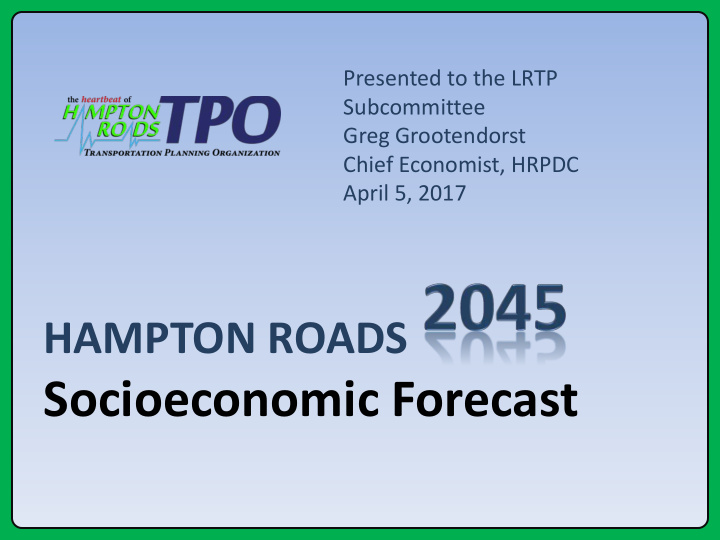



Presented to the LRTP Subcommittee Greg Grootendorst Chief Economist, HRPDC April 5, 2017 HAMPTON ROADS Socioeconomic Forecast
Why do the forecast • Serves as input data for the HRTPO 2045 Long- Range Transportation Plan • Provides an impartial and consistent set of socioeconomic projections that can assist organizations when planning for the region’s future 2 2045 Socioeconomic Forecast Methodology
What is included in the forecast • Population • Employment by place of residence • Employment by place of work – Retail – Industrial – Office – Other • Households • Passenger Vehicle Registrations 3 2045 Socioeconomic Forecast Methodology
Forecast Process Regional Control Totals 1. Literature Review of Forecasting Techniques 2. Review Best Practices 3. Begin Data Collection • Raw Data • Input from Localities Research Assumptions • • Model Inputs 4. Produce Draft Control Totals 5. Produce Draft Jurisdiction Totals 6. Review Draft with Planning Staff/LRTP Subcommittee 7. Present Control Totals for Approval 4 2045 Socioeconomic Forecast Methodology
Forecast Methodology Employment & Population Regional Totals Jurisdiction Allocations Households & Vehicle Registrations 5 2045 Socioeconomic Forecast Methodology
Regional Control Totals - Population Population Forecast through 2045 2,500,000 Peninsula Forecast Southside 2,000,000 1,500,000 1,000,000 500,000 0 1970 1973 1976 1979 1982 1985 1988 1991 1994 1997 2000 2003 2006 2009 2012 2015 2018 2021 2024 2027 2030 2033 2036 2039 2042 2045 6 2045 Socioeconomic Forecast Methodology
Regional Control Totals - Employment Employment Forecast through 2045 1,200,000 Peninsula Southside 1,000,000 Forecast 800,000 600,000 400,000 200,000 0 1970 1973 1976 1979 1982 1985 1988 1991 1994 1997 2000 2003 2006 2009 2012 2015 2018 2021 2024 2027 2030 2033 2036 2039 2042 2045 7 2045 Socioeconomic Forecast Methodology
Employment Categories 2-Digit Industry Sector Retail Office Industrial Other NAICS* 100% Agriculture, Forestry and Fisheries 11 100% Mining 21 10% 90% Construction 23 10% 80% 10% Manufacturing 31,32,33 10% 80% 10% Transportation 48 10% 10% 70% 10% Communications, Utilities 22 40% 10% 20% 30% Wholesale Trade 42 90% 10% Retail Trade 44,45 10% 20% 20% 50% Warehousing 49 60% 10% 30% Information 51 100% Finance, Insurance, Real Estate 52,53,55 30% 30% 10% 30% Administration & Support 56 40% 30% 10% 20% Personal Services 72,81 30% 10% 60% Entertainment, Recreation 71 30% 30% 10% 30% Health Services 62 20% 80% Educational Services 61 90% 10% Other Professional and Related Services 54 10% 40% 20% 30% Public Administration 92 * North American Industrial Classification System 8 2045 Socioeconomic Forecast Methodology
Forecast Uncertainty • Economic (employment, opportunity) • Social (births, immigration, human interaction) • Environmental (sea level rise, climate change) • Technology (health, location decision) 9 2045 Socioeconomic Forecast Methodology
Two-Step Process • Step 1 - HRTPO – Regional Control Totals – Jurisdiction Assignments – Board Approval • Step 2 - Local Staff & HRTPO – Allocation of jurisdictional data to the TAZ level 10 2045 Socioeconomic Forecast Methodology
Questions Greg Grootendorst Hampton Roads Planning District Commission ggrootendorst@hrpdcva.gov 757.420.8300 11 2045 Socioeconomic Forecast Methodology
Forecast Methodology Modeling What is REMI? The Commission’s REMI model was purchased in 2001 and is updated on R egional E conomic M odels, I nc an annual basis. National, state and local data are collected from a variety REMI is one of the most of sources and specifically calibrated advanced and sophisticated for the Hampton Roads Region. dynamic forecasting and policy analysis tools available on the market, widely recognized for quality, accuracy and integrity. Major Data Sources Include: Bureau of Economic Analysis Bureau of Labor Statistics The model contains 169 unique Census industry sectors and over 700 Department of Defense Energy Information Administration policy variables to enable Center for Disease Control simulations that simultaneously County Business Patterns forecast thousands of variables. Research Seminar in Quantitative Economics 2045 Socioeconomic Forecast Methodology
REMI Model Structure (1) Output State and Local Government Consumption Spending Output Real Disposable Income Investment Exports (5) Market Shares (3) Demographic (2) Labor & Capital Demand Domestic Migration International Population Employment Optimal Market Market Share Share Capital Participation Labor Stock Labor/Output Rate Force Ratio (4) Wages, Prices, and Production Costs Composite Wage Wage Rate Employment Opportunity Production Costs Rate Consumer Price Housing Price Real Wage Rate Composite Prices Deflator 2045 Socioeconomic Forecast Methodology
Forecast Methodology Data Collection and Modeling Raw Data • U.S. Census Bureau • Bureau of Economic Analysis • Bureau of Labor Statistics • Virginia Employment Commission • Internal Revenue Service • Professional Literature & Resources • Alternative Forecast Methods – Woods & Poole – Weldon Cooper Center • Information from Localities 2045 Socioeconomic Forecast Methodology
Recommend
More recommend